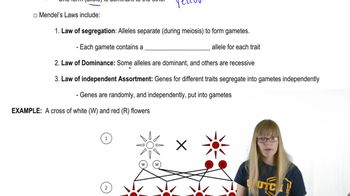A mutation in Arabidopsis immutans results in the necrosis (death) of tissues in a mosaic configuration. Examination of the mitochondrial DNA detects deletions of various regions of the mitochondrial genome in the tissues that are necrotic. When immutans plants are crossed with wild-type plants, the are wild type, and the are wild type and immutans in a 3:1 ratio. Explain the inheritance of the immutans mutation and a possible origin of the mitochondrial DNA deletions.
Table of contents
- 1. Introduction to Genetics51m
- 2. Mendel's Laws of Inheritance3h 37m
- 3. Extensions to Mendelian Inheritance2h 41m
- 4. Genetic Mapping and Linkage2h 28m
- 5. Genetics of Bacteria and Viruses1h 21m
- 6. Chromosomal Variation1h 48m
- 7. DNA and Chromosome Structure56m
- 8. DNA Replication1h 10m
- 9. Mitosis and Meiosis1h 34m
- 10. Transcription1h 0m
- 11. Translation58m
- 12. Gene Regulation in Prokaryotes1h 19m
- 13. Gene Regulation in Eukaryotes44m
- 14. Genetic Control of Development44m
- 15. Genomes and Genomics1h 50m
- 16. Transposable Elements47m
- 17. Mutation, Repair, and Recombination1h 6m
- 18. Molecular Genetic Tools19m
- 19. Cancer Genetics29m
- 20. Quantitative Genetics1h 26m
- 21. Population Genetics50m
- 22. Evolutionary Genetics29m
3. Extensions to Mendelian Inheritance
Organelle DNA
Problem 17
Textbook Question
The first person in a family to exhibit Leber hereditary optic neuropathy (LHON) was II-3 in the pedigree shown below, and all of her children also exhibited the disease. Provide two possible explanations as to why II-3's mother (I-1) did not exhibit symptoms of LHON.

 Verified step by step guidance
Verified step by step guidance1
Identify that Leber hereditary optic neuropathy (LHON) is a mitochondrial disorder, which means it is passed through the maternal line.
Observe that individual II-3 is affected and all her children (III-1, III-2, III-3) are also affected, indicating maternal inheritance.
Consider that I-1, the mother of II-3, might not exhibit symptoms due to heteroplasmy, where a mixture of normal and mutated mitochondria exists, and the proportion of mutated mitochondria is not sufficient to cause symptoms.
Another possibility is that I-1 has a lower penetrance of the disease, meaning she carries the mutation but does not express the symptoms due to other genetic or environmental factors.
Conclude that the absence of symptoms in I-1 does not preclude her from being a carrier of the mitochondrial mutation responsible for LHON.
 Verified video answer for a similar problem:
Verified video answer for a similar problem:This video solution was recommended by our tutors as helpful for the problem above
Video duration:
2mPlay a video:
Was this helpful?
Key Concepts
Here are the essential concepts you must grasp in order to answer the question correctly.
Leber Hereditary Optic Neuropathy (LHON)
LHON is a mitochondrial genetic disorder that primarily affects the optic nerve, leading to vision loss. It is caused by mutations in mitochondrial DNA, which is inherited maternally. The disease typically manifests in young adults, and while it can affect both genders, males are more frequently affected. Understanding LHON's inheritance pattern is crucial for analyzing family pedigrees.
Recommended video:
Guided course

Mendel's Laws
Mitochondrial Inheritance
Mitochondrial inheritance refers to the transmission of genetic traits through mitochondrial DNA, which is passed from mothers to all their offspring. This type of inheritance explains why II-3's children exhibit LHON, as they inherit the affected mitochondrial DNA from their mother. However, it also clarifies why II-3's mother (I-1) may not show symptoms, as not all individuals with mitochondrial mutations express the disease due to factors like variable expressivity.
Recommended video:
Guided course

Organelle Inheritance
Variable Expressivity
Variable expressivity is a phenomenon where individuals with the same genetic mutation exhibit different degrees of severity or even different symptoms of a disease. In the context of LHON, I-1 may carry the mutation but not express the disease due to factors such as environmental influences, other genetic factors, or the specific nature of the mutation. This concept is essential for understanding why some family members may be asymptomatic despite carrying the same genetic risk.
Recommended video:
Guided course

Penetrance and Expressivity

 4:11m
4:11mWatch next
Master Organelle DNA Characteristics with a bite sized video explanation from Kylia
Start learningRelated Videos
Related Practice
Textbook Question
356
views
